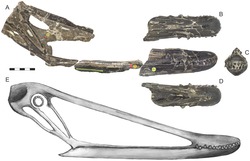Istiodactylus
|
Istiodactylus Temporal range: Early Cretaceous, 125–120 Ma |
|
|---|---|
 |
|
| Photos and reconstruction showing the skull of specimen NHMUK R3877 | |
| Scientific classification | |
| Kingdom: | Animalia |
| Phylum: | Chordata |
| Class: | Reptilia |
| Order: | †Pterosauria |
| Suborder: | †Pterodactyloidea |
| Family: | †Istiodactylidae |
| Genus: |
†Istiodactylus Howse, Milner, & Martill, 2001 |
| Type species | |
|
†Ornithodesmus latidens Seeley, 1901 |
|
| Species | |
|
†I. latidens (Seeley, 1901) |
|
| Synonyms | |
|
Ornithodesmus latidens Seeley, 1901 |
|
†I. latidens (Seeley, 1901)
†?I. sinensis Andres & Qiang, 2006
Ornithodesmus latidens Seeley, 1901
Istiodactylus is a genus of pterosaur that lived during the Early Cretaceous period, about 120 million years ago. The first fossil was discovered on the Isle of Wight in England, and became the holotype specimen of a new species in the genus Ornithodesmus in 1901; O. latidens, Latin for "wide tooth". This species was moved to its own genus, Istiodactylus, in 2001; this name is Greek for "sail finger". More specimens were described in 1913, and Istiodactylus was the only pterosaur known from three-dimensionally preserved fossils for much of the 20th century. In 2006, a species from China, I. sinensis, was assigned to Istiodactylus, but it has since been found to belong to a different genus.
Istiodactylus was a large pterosaur, with estimates of its wing-span ranging from 4.3 to 5 metres (14 to 16 ft) long. Its skull was about 450 millimetres (18 in) long, and was relatively short and broad for a pterosaur. The front of the snout was low, blunt, and bore a semi-circle of 48 teeth. The triangular teeth were closely spaced, interlocked, and formed a "razor-edged" outline. The lower jaw also had a projection that occluded with the teeth. The skull had a very large naso-antorbital opening, and a slender eye socket. Some of the vertebrae were fused into a notarium, to which the shoulder blades connected. It had very large forelimbs, with a wing-membrane distended by a long wing-finger, but the hindlimbs were very short.
Until the 21st century, Istiodactylus was the only known pterosaur of its kind, and was placed in its own family, Istiodactylidae, within the group Ornithocheiroidea. Istiodactylus differed from other istiodactylids by having a proportionally shorter skull. The distinctive teeth of Istiodactylus indicates it was a scavenger, which may have used its teeth to sever morsels from large carcasses like a cookie cutter. The wings of Istiodactylus may have been adapted for soaring, which would have helped it find carcasses before terrestrial carnivores. Istiodactylus is known from the Wessex Formation and the younger Vectis Formation, which represent river and coastal environments, which were shared with various pterosaurs, dinosaurs, and other animals.
...
Wikipedia
